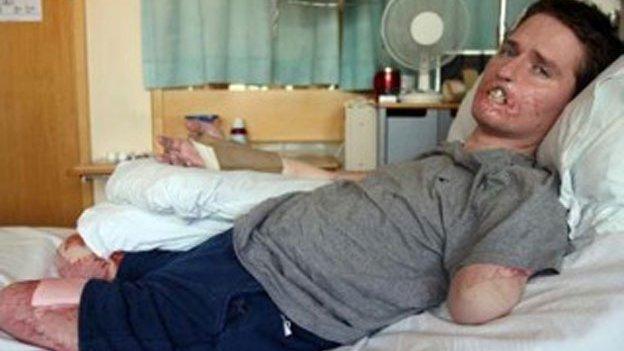How do amputees learn to walk again?
- Published
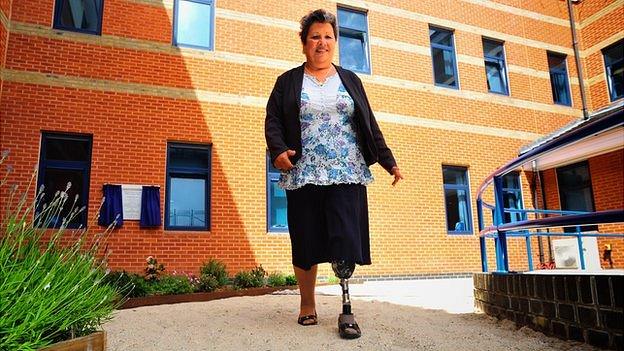
Below-the-knee amputee Sandra Staffiero walks across sand for only the second time at a new 'walking garden' for patients with prosthetic limbs at Colchester Hospital
The "health and spirits" of Alton Towers crash victim Leah Washington are said to be improving "dramatically" following an above the knee amputation. But how do people learn to walk again and rebuild their lives after such drastic surgery?
"My wife June was sat next me," says 61-year-old Graham Facey. "She was pale.
"I said 'I've got an itchy foot' and I tried to scratch it with my other foot and realised it wasn't there. I realised then what had happened."
A diabetic, Mr Facey had just become one of the 6,000 people each year to have a diabetes-related amputation.
Others undergo amputations for other reasons, such as vascular disease or trauma.
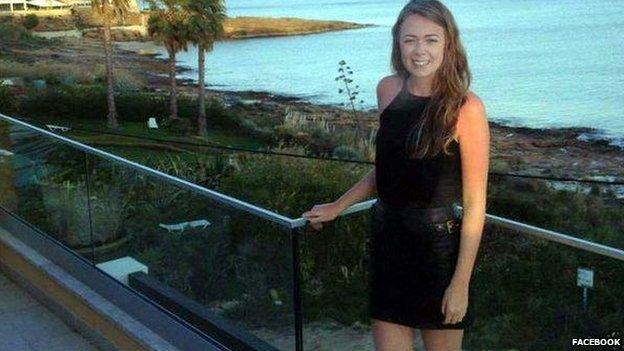
Leah Washington was one of four people severely injured in the rollercoaster crash on 2 June
Trauma includes combat injuries and those suffered by Miss Washington who was on the front row of a carriage on an Alton Towers ride called The Smiler when it hit an empty one.
Those who have undergone the procedure say the public at large is uncomfortable about amputations and that they are sometimes met with stares and general awkwardness.
Here are some of their stories.

Sandra Staffiero
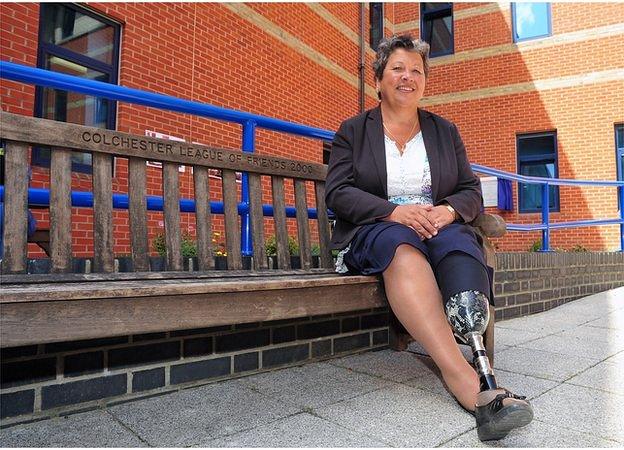
Sandra Staffiero was in so much chronic pain she asked a doctor to amputate her lower leg
Sandra Staffiero, 57, of Hemel Hempstead, Hertfordshire, is a retired school secretary who, aged 20, was involved in a moped crash.
She suffered a double compound fracture which prevented her from walking properly and left her in excruciating chronic pain.
Operations were carried out but the pain remained.
In 2011 she went to her doctor.
"I said 'I cannot carry on like this'," she says. "I had no quality of life. I just asked if he could do a major operation. I did not even mention the word amputation.
"When I made the decision I just felt as though a massive cloud had been lifted.
"It is a decision I have never regretted even though it is a hard life as an amputee.
"I still get lots of stares, often from older people.
"I like to show all the metal. It is not easy, but I now wear skirts. I have put a lot of work into using it to its full potential, so let's show it off.
"From 20 to the age I had this done, I was ashamed and hid my leg from view. But then I got to the stage in my life when I thought 'let's do this, let's show off my metal' and, I suppose, show off my mettle - and I haven't looked back.
"I have cried about the difficulties afterwards but never about the amputation itself."

Roy Birnie

Roy Birnie (pictured here with wife Cathy) says he could still feel his missing leg for a long time afterwards. Sometimes, he says, he can wiggle his toes, "even though they're not there"
Roy Birnie believes in the power of humour. Even when you're being told you need to have you leg cut off beneath the knee.
The 66-year-old, who lives in Colchester with his wife Cathy, had polio as a child.
Before the amputation three-and-a-half years ago (because of a bone infection) he had already had four toes removed (the big toe was allowed to remain for balance).
"I was told the bone infection could have been fatal," says Mr Birnie.
"I was fairly matter of fact about it, to be honest.
"I told the doctor that my big toe had been getting depressed because it was all alone. I approached it with humour.
"The doctor told me he had been out the back trying to work out how to tell me the news. He was surprised I came out with a joke."
The day after the operation, rehabilitation begins.
"The first thing is balance," he says. "The first thing you learn in your hospital bed is to move from the bed to the chair and then from the chair back to the bed.
"Then from the chair to a wheelchair and back again. It is all about learning a new balance because all of a sudden your body is weighted differently."
Then comes walking school using parallel bars.
"This is scary but exciting as well because you're walking again," he says.
"I was back driving (a specially adapted car) within a fortnight."

Amputations
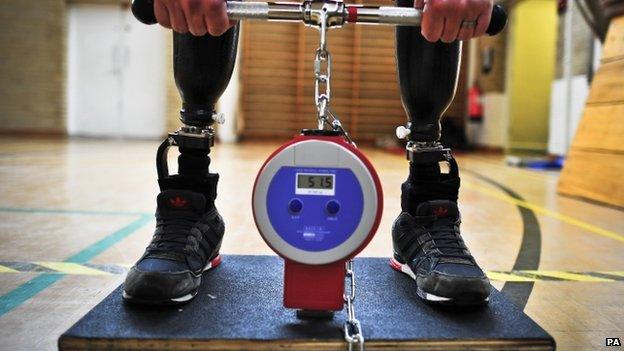
For more information about life after an amputation:
Source: NHS Choices, external

Frances Collins
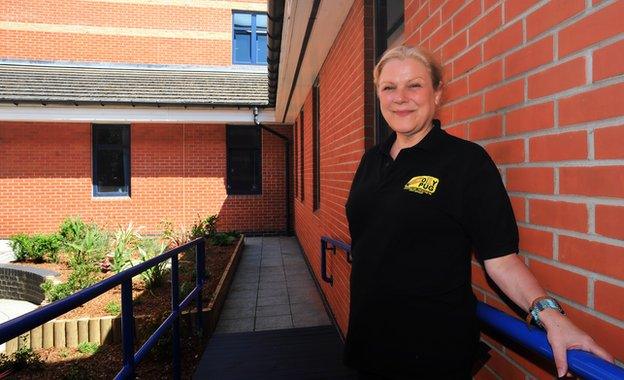
Frances Collins, an above-the-knee amputee, only applied for a blue badge five years ago - and that was because her other knee was causing problems, not because of her prosthesis
"I consider myself one of the lucky ones," says 60-year-old Frances Collins, born with congenital deformities and who had an above-the-knee amputation at the age of 13 months. "Most of the other amputees I know are always comparing what they have lost. I know nothing different.
"I went to a normal school, I climbed trees with my brothers. Children are very tenacious and they will do things that adults often won't try."
"I went to school as a teenager when mini skirts were all the rage. It was horrific. I have lived my life in trousers.
"But I have brought up three children and had a successful career as a teacher."
Throughout her career, she was employed as able-bodied.
"I only got a blue badge five years ago - and that was for my other knee which is getting creaky, not my prosthetic limb."
She said having a baby was like "having a baby" adding: "It changes everything. But everything does not stop, it just changes.
"You can do the things you want, but you just go about doing those things differently.
"There were times I cried. But there are so many positives and us amputees are not self-pitying."

Graham Facey
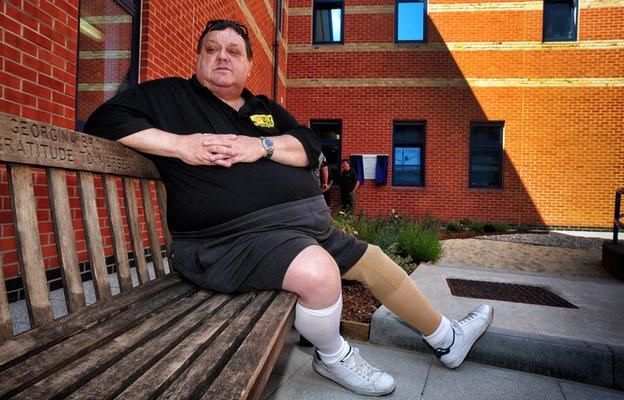
Graham Facey had his lower leg amputated because of gangrenous gas in his foot
Graham Facey, of Tiptree, Essex, woke up feeling he had "trodden on something sharp".
His wife June looked and saw a black dot on the ball of his left foot.
At the time he was a diabetic 49-year-old, who had lost his sight over a weekend three years previously.
He went to hospital and learned he had gangrenous gas in his foot which was poisoning his blood,
"The doctor told me he was sorry but they were going to have to take me down for an operation. I thought they would just open up my foot. I woke up with a blue pen mark on the top of the knee."
He was not told of the amputation beforehand, he says, because it had been "an emergency procedure".
"I had already gone through the grief of losing my eyesight, so I didn't feel the same things about losing my leg. It has become a grief since because it stops me doing things."
Learning to walk again, he says, is all about balance, gait and how to put pressure through the "residual limb" (stump).
"You have to remember you are putting an awful lot of weight on to what is scar tissue," says Mr Facey, who has taken up blind archery and swimming.
As chairman of Colchester Prosthetic User Support Group, Mr Facey counsels other amputees. And their families.
"Families often feel like they are walking on eggshells around an amputee."
It is hard for them, he says. And friends.
"I had a couple of friends who came to see me and they sat there. And I said, 'So it's great you've come to see me. It'd be really good if you could also say something'.
"They said they didn't know what to say to me.
"I told them 'It is still me, that same bloke who was having a beer with you a couple of weeks ago'. I'm still me, but I walk on a stilt."
- Published10 June 2015

- Published11 March 2015

- Published22 January 2015
